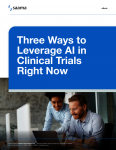New IQVIA research reveals growing trend as pharma embraces combined PV solutions

In her current role as senior director of integrated pharmacovigilance (PV) solutions, she provides senior leadership and oversight to the safety tech-service integrated offering delivery combining IQVIA’s expertise both from a technology and service perspective focusing on accuracy, efficiency, compliance, standardization, and automation. Here she discusses a recent study and how PV is managed by the company.
Can you elaborate on the findings of the study ‘Optimizing End-To-End Safety in Clinical Development with Combined PV Solutions’ regarding the outsourcing trends in pharmacovigilance operations?
The pharmacovigilance (PV) industry has recently seen significant changes due to several factors, including growing volumes of data influx, continuously evolving global regulations and a shortage of skilled experts. Our recent research gathered insights from 125 senior-level executives, of which almost half were C-suite professionals, around their perspectives of combined, outsourced PV services and technology. The survey found that the industry is witnessing an increased reliance on technology and a growing demand for outsourcing combined PV solutions, which aligns with the 7.4% expected compound annual growth rate for outsourced PV solutions between 2023-2030.
Increased product complexity, market competition and pressure from regulatory authorities push organizations to look for ways to minimize risk and cost. As the survey shows, many organizations are looking towards shifting to a combined PV solution that incorporates both services and technology for much needed efficiencies and cost reduction.
What are the primary areas of pharmacovigilance operations that are commonly outsourced by pharmaceutical and biotech companies, according to the study?
The report shows that the primary areas for outsourcing are PV strategy (40%), PV technology/database (38%), Compliance management (34%) and Education/training (33%).
The life sciences industry is experiencing increased competition and pressure from regulatory bodies, patients and providers for real-world data and real-world evidence. Regulatory authorities are bearing down on adverse drug reaction prevention as well as dose optimization, and global discrepancies and country-specific requirements can disrupt PV workflows. To meet the needs of this evolving landscape, companies are calling on vendors to assist through a synergistic PV approach.
Could you discuss the key considerations highlighted by the research when selecting pharmacovigilance technology or database providers?
Across responses some of the most important considerations when selecting PV solutions have to do with data security (45%), cost (44%) and efficiency (42%). The ongoing integration of artificial intelligence (AI) within the life sciences industry has prompted hesitation around automation and data risk, but as technology evolves, signal detection and data mining capabilities will follow suit.
Reducing cost and increasing efficiency remain priorities for pharmaceutical companies as products and regulations alike become more complex and require additional efforts to maintain compliance.
The study mentions that a significant percentage of pharmaceutical companies plan to outsource to vendors that combine pharmacovigilance services with technology. What factors are driving this trend?
Throughout the survey, we saw three consistent main factors that prompted the focus on consolidated PV solutions: compliance, efficiency and cost control.
Companies are looking to continue this focus on combining PV solutions. In fact, 89% plan to outsource vendors that combine services and technology in the future.
Organizations must effectively manage regulatory changes, which typically require adjustments to both processes and technology. With a single vendor monitoring, interpreting and implementing shifts, there is more consistency and accuracy throughout the PV process. No coordination is required for different vendors, therefore there are reduced costs associated with implementation and training. Rather than spending time and effort coordinating between different vendors, companies can focus on their core competencies.
What are the anticipated benefits for pharmaceutical companies in combining pharmacovigilance services with technology, as outlined in the research?
Respondents listed operational efficiency as the key benefit, followed by easier vendor management and reduced time-to-market. Accountability is also critical – a single vendor has a clear vision for processes and technology, how they come together and where the responsibility lies.
The shared platform is visible to all stakeholders and sources, eliminating the number of databases required, alongside the time needed for constant regulatory updates. An inherent benefit of combined PV services and technology is reduced time and effort for overall operations, leading to cost minimization.
Due to increased efficiencies, maintaining high levels of compliance is also more feasible. Organizations can utilize the time saved from coordinating between vendors to focus on compliance efforts.
Can you provide insights into the challenges faced by pharmaceutical companies in managing multiple vendors for pharmacovigilance operations, and how combining services with technology aims to address these challenges?
In terms of managing multiple vendors, pharmaceutical companies face a vast array of challenges. It is difficult to streamline processes and manage activities efficiently when balancing multiple vendors, as there are a variety of moving parts. The research shows that 88% of companies outsource to more than one partner. In the past, partners who could provide services and technology under one umbrella were rare, so there was limited opportunity or choice in outsourcing to more than one vendor. Now, there are opportunities to transition to vendors that offer combined PV services and technology.
There is a lack of accountability when managing multiple vendors as it may be unclear where responsibility falls if an issue arises. Addressing this issue is then difficult when there is no direct visibility into the problem.
The multiple vendor model is also not very cost effective. It leads to different costs per solution, especially for the 49% of organizations that outsource to three to four vendors and the 11% that outsource to five or more. Furthermore, there are additional costs when it comes to the internal resources needed to manage the partners.
Finally, based on the findings of the research, what future trends do you anticipate regarding the integration of technology with pharmacovigilance services in clinical development?
The future of PV outsourcing is bright, and the report's findings support the expected bloom of the market. In fact, these efforts will continue to increase as the growing importance of quality and compliance within PV systems prompts companies to work with vendors that can provide more efficient services and technology.
We will see greater adoption of technology into the PV process in the next three to five years as pharmaceutical companies continue to focus on incorporating different forms of innovation. There is vast investment from a technology and services perspective that has not been seen before, and leaders will look to future proof their PV models through the adoption of technology.

























